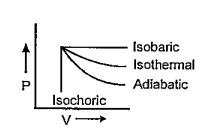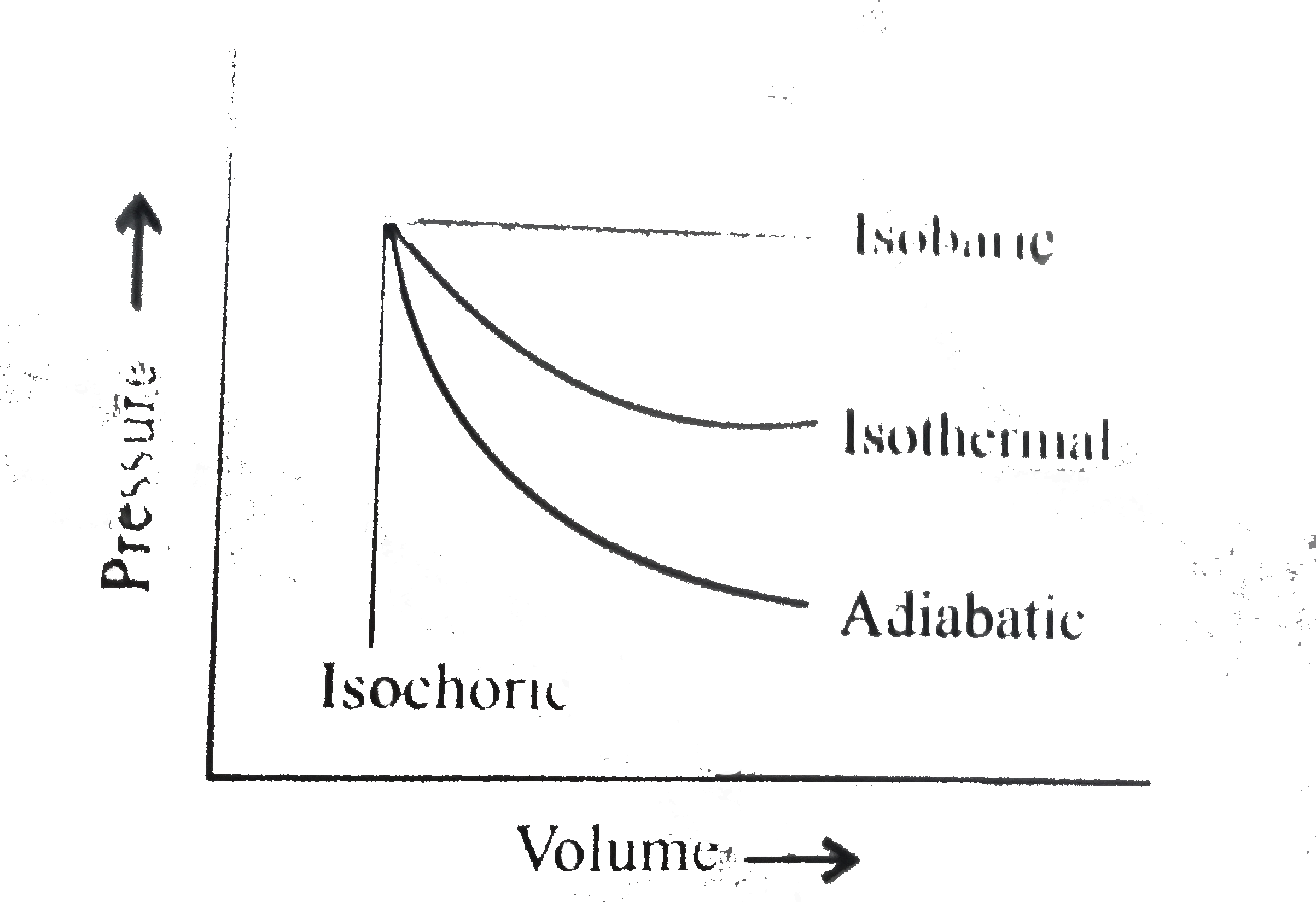If the system involves gaseous substance, then pressure volume work Wpv=−PextΔV. It has been observed that,
Wrev>Wir.

Also the work of isothermal & adiabatic processes are different from each other :
Wisothermalreversib≤=2.303nRTlog(v2v1)
Wadiabaticreversib≤=−Cv(T2−T1)
If W1,W2,W3,W4 are work done in isothermal, adiabatic, isobaric & isochoric reversible processes, then correct sequence would be Solution in Bengali
W1>W2>W3>W4
W3>W2>W1>W4
W_3 gt W_2 gt W_4 gt W_1
W3>W1>W2>W4
The correct Answer is:D
Step by step video, text & image solution for If the system involves gaseous substance, then pressure volume work W_(pv) = -P_(ext)DeltaV. It has been observed that, W_(rev) gt W_(ir). Also the work of isothermal & adiabatic processes are different from each other : W_(isothermal reversible) = 2.303 nRT log(v_2/v_1) W_(adiabatic reversible) = -C_v(T_2-T_1) If W_1, W_2, W_3, W_4 are work done in isothermal, adiabatic, isobaric & isochoric reversible processes, then correct sequence would be by Chemistry experts to help you in doubts & scoring excellent marks in Class 11 exams.
Updated on:21/07/2023Topper's Solved these Questions
Similar Questions
A 1000 mL sample of a gas at −73∘C and 2 atmosphere is heated to 123∘C and the pressure is reduced 0.5 atm. What will be the final volume ?
View SolutionThe pressure-volume of varies thermodynamic process is shown in graphs:

Work is the mole of transference of energy. It has been observed that reversible work done by the system is the maximum obtainable work.
wrev>wirr
The works of isothermal and adiabatic processes are different from each other.
wisothermal reversible=2.303nRTlog10(V2V1)
=2.303nRTlog10(P2P1)
wadiabatic reversible=CV(T1−T2)
If w1,w2,w3 and w4 are work done in isothermal, adiabatic, isobaric, and isochoric reversible processes, respectively then the correct sequence (for expansion) would be
View SolutionThe pressure-volume of varies thermodynamic process is shown in graphs:

Work is the mole of transference of energy. It has been observed that reversible work done by the system is the maximum obtainable work.
wrev>wirr
The works of isothermal and adiabatic processes are different from each other.
wisothermal reversible=2.303nRTlog10(V2V1)
=2.303nRTlog10(P2P1)
wadiabatic reversible=CV(T1−T2)
A thermodynamic system goes in a cyclic process as represented in the following P−V diagram:

The network done during the complete cycle is given by the area
View SolutionThe pressure-volume of varies thermodynamic process is shown in graphs: Work is the mole of transference of energy. It has been observed that reversible work done by the system is the maximum obtainable work. w_(rev) gt w_(irr) The works of isothermal and adiabatic processes are different from each other. w_("isothermal reversible") = 2.303 nRT log_(10) ((V_(2))/(V_(1))) = 2.303 nRT log_(10)((P_(2))/(P_(1))) w_("adiabatic reversible") = C_(V) (T_(1)-T_(2)) P-V plots for two gases during adiabatic processes are given in the given figure: Plot D and Plot C should correspond to
View SolutionThe pressure-volume of varies thermodynamic process is shown in graphs: Work is the mole of transference of energy. It has been observed that reversible work done by the system is the maximum obtainable work. w_(rev) gt w_(irr) The works of isothermal and adiabatic processes are different from each other. w_("isothermal reversible") = 2.303 nRT log_(10) ((V_(2))/(V_(1))) = 2.303 nRT log_(10)((P_(2))/(P_(1))) w_("adiabatic reversible") = C_(V) (T_(1)-T_(2)) Calculate work done when 1 mole of an ideal gas is expanded reversibly form 30L to 60L at a constant temperature of 300k
View SolutionIf w1.w2,w3 and w4 are work done in isothermal, adiabatic, isobaric, and isochoric reversible expansion for an ideal gas, respectively, then
View SolutionWork is the mode of transference of energy. If the system involves gaseous substance and there is difference of pressure between system and surroundings, such a work is referred to as pressure - volume work (WPV=−PextΔV). It has been observed that reversible work done by the system is the maximum obtainable work. wrev>wirr
The works of isothermal and adiabatic processes are different from each other. for isothermal reversible proces,
Wisothermal reversible=2.303nRTlog10(V2V1)
Wadiabatic reversible=CV(T1−T2)
Calculate work done when 1 mole of an ideal gas is expanded reversibly from 20 L to 40 L at a constant temperature of 300 K.
View SolutionWork is the mose of transfrence of energy. If the system involves gaseous substance and there is difference of pressure between system and surroundings, such a work is referred to as pressure - volume work (WPV=−PextΔV). It has been observed that reversible work done by the system is the maximum obtainable work. wrev>wirr
The works of isothermal and adiabatic processes are different from each other. for isothermal reversible proces,
Wisothermal reversible=2.303nRTlog10(V2V1)
Wadiabatic reversible=CV(T1−T2)
Calculate work done when 1 mole of an ideal gas is expended reversibly from 20 L to 40 L at a constant temperature of 300 K.
View SolutionWork is the mose of transfrence of energy. If the system involves gaseous substance and there is difference of pressure between system and surroundings, such a work is referred to as pressure - volume work (W_(PV)= -P_(ext)DeltaV) . It has been observed that reversible work done by the system is the maximum obtainable work. w_(rev) gt w_(ir r) The works of isothermal and adiabatic processes are different from each other. for isothermal reversible proces, W_("isothermal reversible")=2.303 nRT log_(10) (V_(2)/V_(1)) W_("adiabatic reversible")=C_(V) (T_(1)-T_(2)) A thermodynamic system goes in acyclic process as represented in the following P-V diagram: 1. For an ideal gas, consider only P-V work in going from an initial state The net work done during the complete cycle is given by the area:
View SolutionIf w_(1), w_(2), w_(3) and w_(4) for an ideal gas are magnitude of work done in isothermal, adiabatic, isobaric and isochoric reversible expansion processes, the correct order will be :
View SolutionIf W1W2,W3andW4 are work done in isothermal, adiabatic, isobaric and isochoric reversible process, the correct order (for expansion) will be
View SolutionIf w_1, w_2, w_3 , and we are work done in isothermal adiabatic, isobaric and isochoric reversible processes, then the correct sequence (for expansion) would be
View SolutionIf w_(1), w_(2), w_(3) and w_(4) for an ideal gas are magnitude of work done in isothermal, adiabatic, isobaric and isochoric reversible expansion processes, the correct order will be :
View SolutionIf the system involves gaseous substance, then pressure volume work W_(pv) = -P_(ext)DeltaV . It has been observed that, W_(rev) gt W_(ir) . Also the work of isothermal & adiabatic processes are different from each other : W_(isothermal reversible) = 2.303 nRT log(v_2/v_1) W_(adiabatic reversible) = -C_v(T_2-T_1) P-V plot for two gases during adiabatic processes are given as follows : Curves A & B should correspond to respectively
View SolutionThe pressure-volume of varies thermodynamic process is shown in graphs:

Work is the mole of transference of energy. It has been observed that reversible work done by the system is the maximum obtainable work.
wrev>wirr
The works of isothermal and adiabatic processes are different from each other.
wisothermal reversible=2.303nRTlog10(V2V1)
=2.303nRTlog10(P2P1)
wadiabatic reversible=CV(T1−T2)
If w1,w2,w3 and w4 are work done in isothermal, adiabatic, isobaric, and isochoric reversible processes, respectively then the correct sequence (for expansion) would be
View Solution
